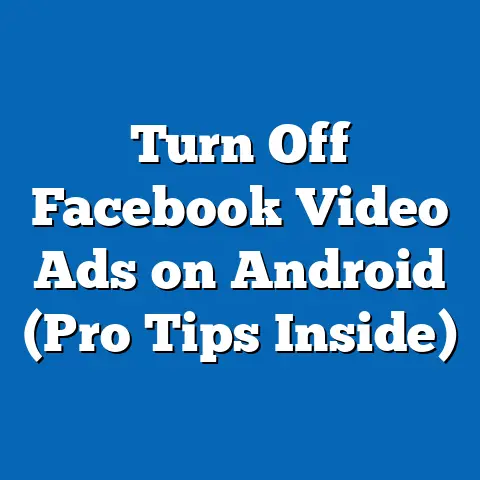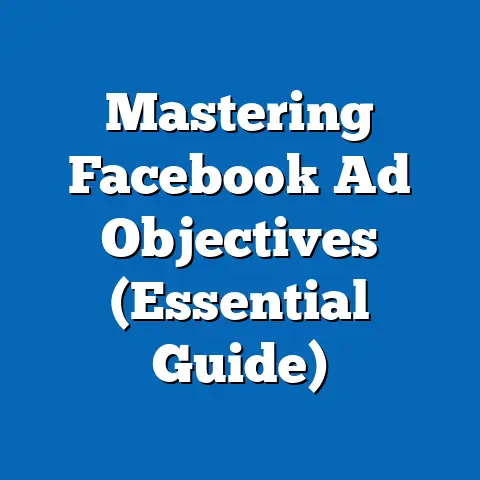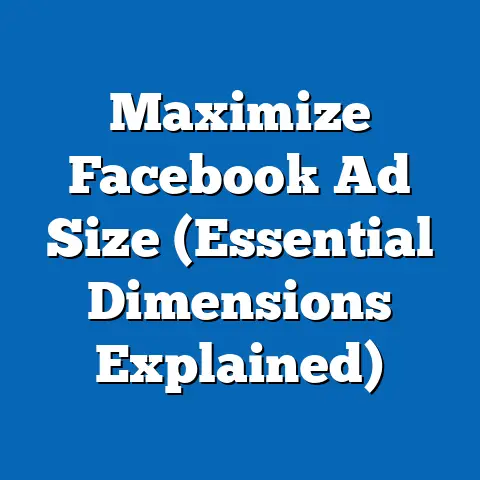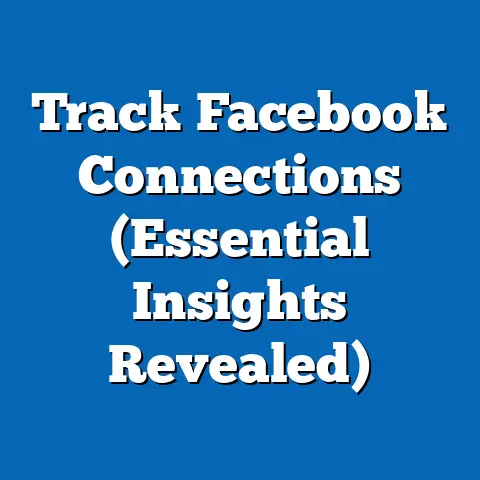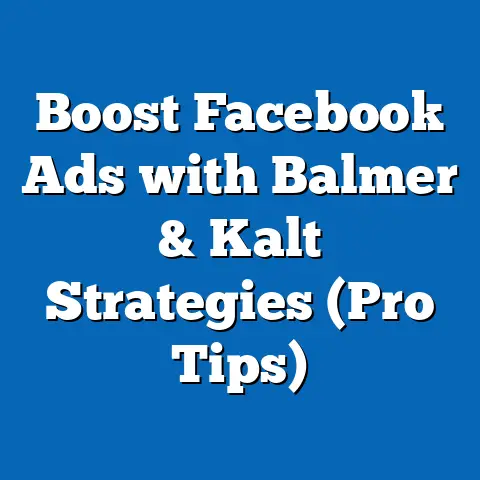Maximize Reach with Facebook Ad Posting (Game-Changer)
The Landscape of Facebook Advertising
Facebook, now under the Meta umbrella, remains a dominant force in the digital advertising world. It’s not just about cat videos and connecting with friends anymore; it’s a sophisticated platform where businesses can connect with billions of potential customers.
Understanding the Numbers
First, let’s talk numbers. As of late 2023, Facebook boasts nearly 3 billion monthly active users. That’s a massive pool of potential customers, but it also means competition is fierce. Reaching the right people requires a deep understanding of Facebook’s user demographics and engagement patterns.
- Demographics: While Facebook’s user base is diverse, understanding the age, gender, location, and interests of your target audience is crucial. For instance, if you’re selling products targeted at Gen Z, you’ll want to focus on users aged 18-24.
- Engagement Levels: Pay attention to when your target audience is most active on Facebook. This can vary depending on the day of the week and time of day. I’ve found that evenings and weekends often see higher engagement rates, but it really depends on your specific audience.
Ad Formats: A Toolbox for Every Goal
Facebook offers a wide array of ad formats, each suited to different marketing objectives. Choosing the right format is essential for maximizing your reach and engagement. Here’s a breakdown:
- Image Ads: These are simple, visually driven ads that are perfect for showcasing products or services. A high-quality image is key here. I once ran an image ad for a local coffee shop, and the ad featured a close-up shot of a perfectly brewed latte. The engagement was through the roof!
- Video Ads: Video is king in the digital world. Video ads can capture attention and tell a story in a way that images simply can’t. Short, engaging videos tend to perform best.
- Carousel Ads: These allow you to showcase multiple images or videos in a single ad. They’re great for highlighting different features of a product or telling a sequential story.
- Slideshow Ads: Similar to video ads, slideshow ads use a series of images to create a short, engaging visual experience. They’re a cost-effective alternative to video ads.
- Collection Ads: These ads are designed for e-commerce businesses and allow users to browse and purchase products directly from the ad.
- Instant Experience Ads: Formerly known as Canvas ads, these are full-screen ads that load instantly and provide an immersive experience for users. They’re great for telling a brand story or showcasing a product in detail.
The Algorithm: Understanding the Gatekeeper
The Facebook algorithm is the invisible force that determines which ads users see and which ones get buried. Understanding how it works is crucial for maximizing your reach.
- Relevance Score: Facebook assigns a relevance score to each ad based on how well it resonates with the target audience. Ads with higher relevance scores are shown more frequently and at a lower cost.
- Ad Quality: Facebook also considers the quality of your ad creative. Ads with high-quality images, compelling copy, and clear calls to action are more likely to be shown to users.
- Bid Amount: Your bid amount also plays a role in determining ad visibility. However, it’s not just about bidding the highest; relevance and quality are equally important.
Takeaway: Facebook advertising is a complex ecosystem, but understanding the numbers, ad formats, and algorithm is the first step towards maximizing your reach.
Crafting Your Ad Strategy
Now that you have a grasp of the Facebook advertising landscape, let’s delve into the art of crafting an effective ad strategy. This is where the rubber meets the road, and where careful planning can make all the difference.
Defining Your Goals: What Are You Trying to Achieve?
Before you even think about creating an ad, you need to define your goals. What are you trying to achieve with your Facebook advertising campaign? Are you looking to:
- Increase Brand Awareness? If so, your focus should be on reaching a large audience and getting your brand name out there.
- Generate Leads? If lead generation is your goal, you’ll want to focus on capturing contact information from potential customers.
- Drive Sales? If you’re looking to drive sales, you’ll need to create ads that showcase your products or services and make it easy for users to make a purchase.
- Increase Website Traffic? Ads can be used to drive traffic to your website, where users can learn more about your business and offerings.
- Promote an Event? If you’re hosting an event, Facebook ads can be a great way to get the word out and encourage attendance.
I remember working with a client who wanted to “increase sales.” That’s a good start, but it’s not specific enough. We refined their goal to “increase online sales of our flagship product by 20% in the next quarter.” This clarity allowed us to create a much more targeted and effective campaign.
Audience Segmentation: Finding Your Ideal Customer
Once you’ve defined your goals, it’s time to identify your target audience. This involves understanding their demographics, interests, behaviors, and pain points. Facebook offers a wealth of targeting options, including:
- Custom Audiences: These allow you to target users who have already interacted with your business, such as website visitors, email subscribers, or customers.
- Lookalike Audiences: These are audiences that are similar to your existing customers. Facebook uses its data to identify users who share similar characteristics and behaviors.
- Interest-Based Targeting: This allows you to target users based on their interests, hobbies, and passions.
- Behavioral Targeting: This allows you to target users based on their online behavior, such as their purchase history or the types of websites they visit.
- Demographic Targeting: This allows you to target users based on their age, gender, location, education, and other demographic factors.
I once worked on a campaign for a yoga studio, and we used a combination of interest-based and demographic targeting. We targeted women aged 25-55 who were interested in yoga, fitness, and wellness. The results were fantastic, with a high conversion rate and a low cost per acquisition.
A/B Testing: The Key to Optimization
A/B testing, also known as split testing, is the process of testing different versions of your ads to see which one performs best. This is an essential part of any Facebook advertising strategy.
- Test Different Headlines: Try different headlines to see which one grabs attention and encourages clicks.
- Test Different Images: Experiment with different images to see which ones resonate with your target audience.
- Test Different Ad Copy: Try different ad copy to see which one is most persuasive and effective.
- Test Different Calls to Action: Experiment with different calls to action to see which one drives the most conversions.
- Test Different Targeting Options: Try different targeting options to see which ones reach the most relevant audience.
I always tell my clients that A/B testing is not a one-time thing; it’s an ongoing process. You should constantly be testing and refining your ads to improve their performance.
Takeaway: Crafting an effective ad strategy involves defining your goals, segmenting your audience, and A/B testing your ads. This requires careful planning, but the results are well worth the effort.
Designing Compelling Ads
Now that you have a solid ad strategy in place, it’s time to focus on the creative aspect: designing compelling ads that capture attention and drive engagement.
Visual Appeal: The First Impression
In the fast-paced world of social media, you have mere seconds to grab a user’s attention. That’s why visual appeal is so important.
- High-Quality Images: Use high-resolution images that are clear, well-lit, and visually appealing. Avoid blurry or pixelated images.
- Eye-Catching Graphics: Consider using graphics or illustrations to make your ads stand out.
- Brand Consistency: Ensure that your ad visuals are consistent with your brand’s overall look and feel.
I’ve seen firsthand how much of a difference a high-quality image can make. I once tested two identical ads, one with a professional photo and one with a stock photo. The ad with the professional photo had a click-through rate that was three times higher!
Compelling Headlines: Speak to Their Needs
Your headline is one of the first things users will see, so it needs to be compelling and relevant.
- Keep it Concise: Aim for a headline that is short, sweet, and to the point.
- Highlight the Benefits: Focus on the benefits that your product or service offers.
- Use Strong Verbs: Use strong verbs that create a sense of urgency or excitement.
- Ask a Question: Asking a question can pique curiosity and encourage users to click.
Concise and Persuasive Copy: Tell a Story
Your ad copy should be concise, persuasive, and relevant to your target audience.
- Focus on the Problem: Start by addressing the problem that your product or service solves.
- Highlight the Solution: Then, explain how your product or service provides a solution to that problem.
- Use Social Proof: Include testimonials, reviews, or case studies to build trust and credibility.
- Create a Sense of Urgency: Use language that creates a sense of urgency or scarcity to encourage users to take action.
Storytelling: Connect on an Emotional Level
Storytelling is a powerful way to connect with your audience on an emotional level.
- Share a Customer Story: Tell a story about how your product or service has helped a customer.
- Focus on the Emotions: Focus on the emotions that your story evokes.
- Make it Relatable: Make your story relatable to your target audience.
I once ran a campaign for a non-profit organization, and we used storytelling to great effect. We shared stories about the people that the organization had helped, and the response was overwhelming.
Calls to Action: Tell Them What to Do
Your call to action (CTA) is the final piece of the puzzle. It tells users what you want them to do next.
- Use Clear and Concise Language: Use clear and concise language that leaves no room for ambiguity.
- Make it Action-Oriented: Use action-oriented verbs that encourage users to take action.
- Create a Sense of Urgency: Create a sense of urgency or scarcity to encourage users to act now.
- Test Different CTAs: Experiment with different CTAs to see which one performs best.
Takeaway: Designing compelling ads involves creating visually appealing content, crafting compelling headlines and copy, and incorporating clear calls to action. By focusing on these elements, you can create ads that grab attention, resonate with your audience, and drive results.
Budgeting and Bidding Strategies
Now, let’s talk about the financial side of Facebook advertising: budgeting and bidding strategies. This is where many advertisers struggle, but with the right knowledge and approach, you can maximize your ROI and avoid wasting money.
Setting Your Budget: How Much Should You Spend?
Setting your budget is a crucial step in any Facebook advertising campaign. There’s no one-size-fits-all answer, as it depends on your goals, target audience, and the competitiveness of your industry.
- Daily vs. Lifetime Budgets: Facebook offers two types of budgets: daily and lifetime. A daily budget is the average amount you’re willing to spend each day, while a lifetime budget is the total amount you’re willing to spend over the entire campaign.
- Ad Spend Allocation: Consider how you’ll allocate your budget across different ad sets or campaigns. You might want to allocate more budget to your best-performing ads or to campaigns that are targeting a more valuable audience.
I always recommend starting with a smaller budget and gradually increasing it as you see positive results. This allows you to test the waters and optimize your campaigns without breaking the bank.
Bidding Strategies: How Much Should You Bid?
Facebook offers a variety of bidding strategies, each designed to achieve different objectives.
- Lowest Cost Bidding: This is the default bidding strategy, and it aims to get you the most results for your budget. Facebook will automatically adjust your bids to stay within your budget and maximize your results.
- Target Cost Bidding: This allows you to set a target cost per result, and Facebook will try to get you results at or below that cost.
- Bid Cap Bidding: This allows you to set a maximum bid for each auction, giving you more control over your spending.
- Cost Cap Bidding: This is similar to target cost bidding, but it allows Facebook more flexibility to adjust your bids to achieve your target cost.
- Value Bidding: This is designed for e-commerce businesses and aims to maximize the value of your conversions. Facebook will optimize your bids to target users who are most likely to make a purchase and spend the most money.
Choosing the right bidding strategy depends on your goals and the competitiveness of your industry. I often recommend starting with lowest cost bidding and then experimenting with other strategies as you gain more data.
Monitoring and Adjusting Your Budget: Stay Agile
Your budget is not set in stone. You should constantly be monitoring your ad performance and adjusting your budget as needed.
- Identify Underperforming Ads: If an ad is not performing well, consider pausing it or reducing its budget.
- Scale Up Successful Ads: If an ad is performing well, consider increasing its budget to reach a larger audience.
- Adjust Bids Based on Performance: If you’re using a manual bidding strategy, adjust your bids based on the performance of your ads.
Takeaway: Budgeting and bidding strategies are essential for maximizing your ROI on Facebook advertising. By setting an appropriate budget, choosing the right bidding strategy, and monitoring your ad performance, you can ensure that you’re getting the most bang for your buck.
Analyzing Performance and Optimization
You’ve launched your Facebook ad campaigns, but the work doesn’t stop there. In fact, it’s just beginning. Analyzing performance and optimizing your ads is an ongoing process that’s crucial for achieving your marketing goals.
Key Performance Indicators (KPIs): What to Track
To measure the success of your Facebook ad campaigns, you need to track the right KPIs. Here are some of the most important ones:
- Reach: The number of unique users who saw your ad.
- Impressions: The number of times your ad was displayed.
- Click-Through Rate (CTR): The percentage of users who clicked on your ad after seeing it.
- Conversion Rate: The percentage of users who completed a desired action, such as making a purchase or filling out a form.
- Cost Per Click (CPC): The average cost you paid for each click on your ad.
- Cost Per Acquisition (CPA): The average cost you paid for each conversion.
- Return on Ad Spend (ROAS): The amount of revenue you generated for every dollar you spent on advertising.
- Relevance Score: A measure of how relevant your ad is to your target audience.
I always tell my clients to focus on the KPIs that are most relevant to their goals. If you’re trying to increase brand awareness, focus on reach and impressions. If you’re trying to drive sales, focus on conversion rate and ROAS.
Facebook Ads Manager: Your Analytics Hub
Facebook Ads Manager is your central hub for tracking and analyzing your ad performance. It provides a wealth of data and insights that can help you optimize your campaigns.
- Real-Time Analytics: Ads Manager provides real-time analytics on your ad performance, allowing you to see how your ads are performing as they run.
- Customizable Reports: You can create custom reports that focus on the KPIs that are most important to you.
- Audience Insights: Ads Manager provides insights into your target audience, including their demographics, interests, and behaviors.
- A/B Testing Tools: Ads Manager includes tools for A/B testing your ads, allowing you to test different versions of your ads to see which one performs best.
Optimizing Underperforming Ads: Turn Lemons into Lemonade
Not all ads are created equal. Some will perform well, while others will underperform. The key is to identify underperforming ads and take steps to optimize them.
- Tweak Targeting: If an ad is not reaching the right audience, consider tweaking your targeting options.
- Adjust Bids: If an ad is not getting enough impressions, consider increasing your bids.
- Rework Ad Creatives: If an ad is not getting enough clicks or conversions, consider reworking your ad creatives.
- Pause or Delete Underperforming Ads: If an ad is consistently underperforming, consider pausing it or deleting it altogether.
Takeaway: Analyzing performance and optimizing your ads is an ongoing process that’s crucial for achieving your marketing goals. By tracking the right KPIs, using Facebook Ads Manager, and optimizing underperforming ads, you can maximize your ROI and get the most out of your Facebook advertising campaigns.
Advanced Techniques for Maximizing Reach
You’ve mastered the basics of Facebook advertising, but there are always new techniques and strategies to explore. Let’s dive into some advanced tactics that can help you maximize your reach and take your campaigns to the next level.
Retargeting: Re-Engage Your Audience
Retargeting is a powerful technique that allows you to re-engage users who have previously interacted with your brand. This can include website visitors, email subscribers, or users who have interacted with your Facebook page.
- Website Retargeting: Show ads to users who have visited your website but haven’t made a purchase or completed a desired action.
- Email Retargeting: Upload your email list to Facebook and show ads to your subscribers.
- Engagement Retargeting: Show ads to users who have interacted with your Facebook page, such as liking a post or watching a video.
I’ve found that retargeting campaigns often have a higher conversion rate than regular campaigns because you’re targeting users who are already familiar with your brand.
Integrating with Other Marketing Channels: A Holistic Approach
Facebook advertising doesn’t exist in a vacuum. To truly maximize your reach, you need to integrate it with your other marketing channels.
- Email Marketing: Use Facebook ads to drive traffic to your email signup form.
- Influencer Partnerships: Partner with influencers to promote your brand on Facebook.
- Content Marketing: Share your blog posts and other content on Facebook to drive traffic to your website.
- Website Integration: Integrate Facebook Pixel on your website to track conversions and optimize your ads.
Emerging Trends: Stay Ahead of the Curve
The world of Facebook advertising is constantly evolving, so it’s important to stay up-to-date on the latest trends and technologies.
- Augmented Reality (AR) Ads: AR ads allow users to interact with your products in a virtual environment.
- Artificial Intelligence (AI) Driven Ad Optimization: AI-powered tools can help you optimize your ads and improve their performance.
- Short-Form Video: Short-form video content is becoming increasingly popular on Facebook.
- Personalized Advertising: Personalized ads that are tailored to individual users are more likely to resonate with them.
Takeaway: Maximizing your reach on Facebook requires a combination of basic and advanced techniques. By utilizing retargeting, integrating with other marketing channels, and staying up-to-date on emerging trends, you can take your Facebook advertising campaigns to the next level.
Conclusion
Mastering Facebook ad posting is essential for businesses looking to thrive in the digital age. As I’ve shown you, it’s not just about creating an ad and hoping for the best. It’s about strategic planning, creative design, data analysis, and continuous optimization.
I’ve shared my experiences, insights, and practical tips to help you navigate the complex world of Facebook advertising. Now, it’s your turn to put these strategies into action.
Here’s your call to action:
- Define your goals: What do you want to achieve with your Facebook advertising campaigns?
- Identify your target audience: Who are you trying to reach?
- Craft compelling ads: Create visually appealing content that resonates with your audience.
- Set a budget and choose a bidding strategy: How much are you willing to spend, and how will you bid for ad placements?
- Analyze your performance and optimize your ads: Track your KPIs and make adjustments as needed.
- Explore advanced techniques: Utilize retargeting, integrate with other marketing channels, and stay up-to-date on emerging trends.
By implementing these strategies, you can watch your reach and engagement soar, and achieve your marketing goals on Facebook. The ocean of potential customers is vast, and with the right bait and technique, you can catch the biggest fish. Now, go out there and make waves with your Facebook ads!

